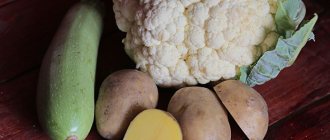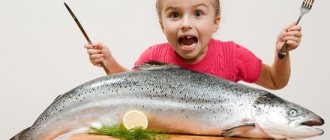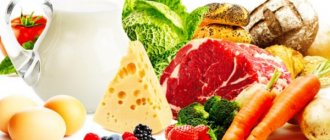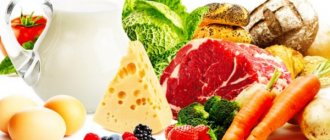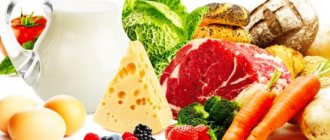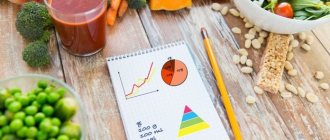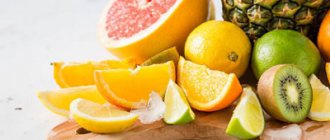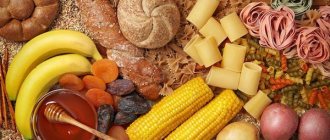Carbohydrates are the main suppliers of energy for the body and one of the most dangerous enemies of a slim figure. If you want to lose weight, use them very carefully.
On the one hand, a significant restriction of carbohydrate foods has a bad effect on the functioning of the brain and nervous system, and interferes with the development and growth of muscles. A sharp rejection of these energetically valuable substances forces the body to defend itself: hormonal levels change, metabolism slows down, and every extra calorie goes into fat reserves.
On the other hand, too much carbohydrates leads to decreased activity, rapid growth of fat mass, and inhibition of muscle growth. And it’s easy to overeat carbohydrate foods: sweets are very attractive to our brain. Fast and tasty energy will always attract him. Therefore, you will have to show your will so that in the pursuit of pleasure you do not gain extra pounds.
One option for losing weight is to add more sugar-free foods to your diet, filled with vitamins, proteins, microelements and healthy complex carbohydrates.
Slow carbohydrates
These include polysaccharides (for example, starch). You should not believe those who blame this particular product for weight gain. Polysaccharides are absorbed by the stomach at a minimal speed, so they make it easy to maintain carbohydrate balance. Starch contained in cereals, vegetables and many fruits makes such food nutritious. Think about what our ancestors ate a couple of thousand years ago: it was a simple diet high in carbohydrates, which differed from the diet of modern humans in its balance. Therefore, it is important to ensure that easily digestible substances containing starch enter the body. It is he who will provide us with energy.
Fast carbohydrates
Another type of carbohydrate contains mono- and disaccharides. These are ordinary sugar, glucose and fructose. Food containing these substances requires especially close monitoring. Sucrose is absorbed by the body at a high speed, but this does not always meet the needs. Under normal conditions, its excess is transformed into glycogen, but when its reserves are large, glucose begins to turn into fat. This is why foods containing such substances are prohibited in almost any diet. Even if your goal is not to lose excess weight, but only to monitor your health, you need to choose those dishes that have a reduced amount of “harmful” substances.
Which foods contain the least amount of carbohydrates?
Nutritionists have developed several tables with data on the carbohydrate content of a particular food. Typically, you can see side by side the amount of protein and fat they contain and total calories. Data is usually indicated per 100 g of product. The list of low-carb foods is topped by meat:
- beef;
- veal;
- mutton;
- pork;
- loin;
- heart;
- rabbit;
- chicken;
- geese;
- ducks
This also includes vegetable oil, river and sea fish, seafood and caviar.
The list of drinks containing virtually no carbohydrates included tea and coffee without sugar, mineral water, whiskey, vodka, cognac and rum. A very small amount of carbohydrates (from 0.1 to 1 g per 100 g of product) contains:
- eggs;
- dietary cottage cheese;
- margarine;
- Champignon;
- fresh boletus and honey mushrooms;
- capers;
- lobsters;
- sea kale.
This also includes dry red and white wines. The following also have a low amount of sugars (from 1 to 5 g per 100 g):
- fresh chanterelles and boletus;
- Russula;
- chicken liver;
- "Doctor's sausage";
- beef and pork sausages;
- crabs;
- fatty cottage cheese;
- mayonnaise;
- sour cream;
- spinach;
- green beans;
- cucumbers;
- lemon;
- asparagus;
- sorrel.
Almost all of the listed products can be found in carbohydrate-free diets or in those diets that significantly limit the intake of such substances into the body.
Carbohydrates: how to calculate the norm?
Theoretically, you can do without carbohydrates. For example, they are practically absent from Chukchi food; they are replaced by a huge amount of protein (85%) and fat (5%). The fact is that our liver can process proteins and fats into carbohydrates, and among the northern peoples, evolution has brought this process to perfection. But a European who does not get the required amount of carbohydrates will feel constant fatigue. No wonder: from them we extract 50% of the incoming energy. Carbohydrates are fuel for every cell in the body, including the brain and muscles. DIFFERENT ENERGY Carbohydrates are simple and complex. Simple, or fast, are sweets, fruits, white bread... They contain sugars that are easily converted into glucose and absorbed into the blood - faster than the energy from them is consumed. Half an hour after we ate a bunch of grapes or a donut, the glucose obtained from them has already entered the brain and muscles. Alas, simple carbohydrates easily turn into fat, which not only spoils your figure, but also becomes harmful ballast. The amount of bad cholesterol in the blood increases, blood vessels become clogged and lose elasticity, atherosclerosis, hypertension and many other diseases develop. Complex, or slow carbohydrates, are primarily all kinds of cereals, bread (not sweet baked goods, but whole grain or with bran), durum wheat pasta and vegetables. They break down in the intestines for a relatively long time, and in the end they also produce glucose. It slowly enters the bloodstream over 1–4 hours, gradually supplying the body with energy. Thus, complex carbohydrates are burned, almost without having time to be deposited in fat. Accordingly, their nutritional value is higher, and the benefits from them are much greater than from simple ones. In addition, many foods rich in complex carbohydrates (such as whole grains, fruits and vegetables) also contain phytonutrients that are beneficial to our health, such as flavonoids.
| HOW MANY CALORIES ARE THERE? 1 g of carbohydrates contains 4.1 kcal. Proteins have just as many calories. 1 g of fat contains 9.3 kcal. |
REHABILITATION OF FAST However, this does not mean that simple carbohydrates should be eliminated altogether and replaced with complex ones. The brain often needs a quick supply of glucose. Although it makes up 2–4% of body weight, it consumes up to 25% of all the energy the body needs. In addition, fast-acting carbohydrate fuel is necessary for the normal functioning of the central nervous system. Another case when fast carbohydrates cannot be avoided is hypoglycemia, a condition when blood sugar levels drop sharply. This can happen to a completely healthy person due to overwork, severe stress, changes in atmospheric pressure... A piece of sugar or a chocolate bar will save you from loss of consciousness or serious vascular failure. Complex carbohydrates are not able to provide such immediate help to the body. TURN ON THE CALCULATOR Nutritionists and physiologists have spent quite a long time researching and arguing about how many and what kind of carbohydrates we need to achieve balance. In the end, we came to the conclusion: the optimal ratio of fast and slow carbohydrates in the diet is approximately 1:3. A person should get 53–60% of their calories from carbohydrates. The lower threshold is for those who want to lose weight, the upper threshold is for those who want to gain weight. The most important determining factor of carbohydrate norm is the degree of load. Those who lead an active lifestyle and/or are engaged in intense mental work need noticeably more carbohydrates than people who do not exert themselves either literally or figuratively. If you want to lose extra pounds, the calorie content of your diet, of course, needs to be reduced through carbohydrates and fats. But in any case, you need to get about 50% of your total daily calories from carbohydrates, even if you are losing weight. It’s just that in this case complex ones should prevail rather than simple ones. It is important not to eat your entire daily carbohydrate intake at once, but to distribute it over several servings. The ideal serving is 50 g of net carbohydrates: this is two slices of bread, a bowl of oatmeal or a small piece of halva. More options that will make the calculation easier are in our table. THREE CARBOHYDRATE MENU PER DAY FOR OFFICE WORKERS You do not lead a very active lifestyle, but do not want to gain weight. The daily norm is 1400 kcal/day, of which carbohydrates should account for about 800 kcal (approximately 200 g of carbohydrates in several servings). Breakfast Buckwheat porridge (150 g) – 66 g carbohydrates. Low-fat yogurt (125 g) – 45 g carbohydrates. Tea (200 ml) with sugar (1 tsp) – 8 g carbohydrates.
| 3 SIGNS OF PRODUCTS RICH IN FAST CARBOHYDRATES Sweetness. More or less pronounced, it always indicates that the product contains glucose. Tenderness. The softer the product, the easier it is to chew, the more simple carbohydrates it contains. For example, there are much more of them in melon and bananas than in beets, despite the fact that beets are also sweet. Unnaturalness. The more processed a product is, the less healthy it is and the more glucose it contains. Potato chips contain more simple carbohydrates than boiled and baked potatoes. |
TOTAL: fast - 53 g, slow - 66 g (119 g). Lunch Borscht with beans and sour cream (250 g) – 15 g carbohydrates. Steak with boiled potatoes (200 g) – 40 g carbohydrates. TOTAL: fast - 0 g, slow - 55 g (55 g). Dinner Fresh carrot salad (100 g) – 8 g carbohydrates. Stewed zucchini with sour cream (200 g) - 15 g. TOTAL: fast - 8 g, slow - 15 g (23 g). TOTAL: 197 g of carbohydrates (61 g - fast, 136 g - slow). FOR THE ACTIVE You move a lot and/or work hard mentally. The daily norm is 2000–2200 kcal/day, of which about 1300 kcal comes from carbohydrates (350–400 g of carbohydrates). Breakfast Rolled oats boiled in water with bran and dried apricots (250 g) – 57 g of carbohydrates. 1 toast with jam (30 g) – 15 g carbohydrates. Tea or coffee with condensed milk (10 g) – 23 g carbohydrates. TOTAL: fast - 50 g, slow - 45 g (117 g). Lunch Beet salad with nuts and prunes (100 g) – 30 g carbohydrates. Rice soup with meat (200 g) – 10 g carbohydrates. Boiled potatoes (200 g) – 40 g carbohydrates. Beef cutlets (150 g) – 10 g carbohydrates. Vanilla ice cream (100 g) – 50 g carbohydrates. TOTAL: fast - 80 g, slow - 75 g (140 g). Dinner Stewed eggplant (200 g) – 17 g carbohydrates. Macaroni and cheese (200g) – 110g carbs. 2 apricots (50 g) – 10 g carbohydrates. Tea with sugar (1 tsp) – 8 g carbohydrates. TOTAL: fast - 18 g, slow - 122 g (140 g). TOTAL: 397 g carbohydrates (170 g - fast, 242 g - slow). FOR WEIGHT LOSSERS You want to lose weight without harm to your health. The daily norm is 1200 kcal, of which 600 kcal with carbohydrates (about 170 g of carbohydrates). Breakfast Oatmeal (200 g) – 50 g carbohydrates. Tea with sugar (2 tsp) – 16 g carbohydrates. Toast with cheese (30 g) – 15 g carbohydrates. TOTAL: fast - 16 g, slow - 65 g (81 g). Lunch Boiled meat with green salad, green peas and pepper (250 g) – 35 g carbohydrates. A handful of dried fruits (30 g) – 25 g of carbohydrates. TOTAL: fast - 25 g, slow - 35 g (60 g). Dinner Cottage cheese with prunes (250 g) – 14 g carbohydrates.
Fried zucchini (150 g) – 10 g carbohydrates. TOTAL: fast - 14 g, slow - 10 g (24 g). TOTAL: 167 g of carbohydrates (55 g - fast, 110 g - slow). Published: September 22, 2021
What foods contain moderate amounts of carbohydrates?
As a rule, such foods are not very strictly limited by nutritionists, but obese people should still avoid them. Moderately high amounts of carbohydrates (6-10) have:
- oysters;
- dried porcini mushrooms;
- sweet yogurt;
- green pea;
- radish;
- swede;
- horseradish;
- beet;
- strawberry;
- cherry plum;
- grapefruit;
- carrot;
- raspberries;
- mandarin;
- white currant;
- orange;
- melon;
- apricot;
- pear;
- plum.
There are even more sugars (11-15 per 100 g of product) in some other vegetables and fruits:
- pomegranate;
- figs;
- a pineapple;
- cherry and orange juice;
- grape;
- walnuts, hazelnuts and pistachios;
- corn.
What can you eat on a low-carbohydrate diet (Allowed foods)
Allowed and recommended foods for a low-carbohydrate diet include, of course, meat. From boiled chicken breast to camel meat.
The most popular:
- poultry meat - chicken, turkey;
- fish - trout, mackerel, salmon, cod, herring, flounder and tuna;
- red meat - rabbit, veal, beef, lamb, rarely - pork, since such meat is too fatty;
- dairy products - kefir, milk, cottage cheese, cheese containing about 5% protein, fermented baked milk, sour cream.
A strict version of the diet is the exclusion of fruits, vegetables and cereals, or their consumption in very small quantities. But, if this is your first time on such a diet, experts still advise including these products in your menu.
So, only a few fruits are allowed: all citrus fruits, peaches, sour apples and coconut. You can make juices, add them to cereals, use them as a snack, or eat them separately.
Some vegetables are also allowed, mostly all green: celery, cucumbers, peppers, lettuce, basil, parsley, dill, white cabbage, cilantro, arugula. Zucchini, eggplant, and beans are great for heat-treated side dishes, which, by the way, contain a lot of protein.
Nuts are very healthy! In addition to the fact that they are rich in protein, nuts contain healthy fats that make your hair, nails, skin beautiful, and are responsible for external beauty and sparkle in your eyes. You just need to regularly (2-3 times a week) eat a handful of walnuts, peanuts, cashews, almonds, hazelnuts, and pistachios.
Include cereals in your diet at least several times a week: buckwheat, peas, cilantro, oatmeal - all these cereals are rich in proteins and, at the same time, contain the necessary fiber.
Lastly, keep an eye on your condition. If you experience depression, slow thinking, loss of concentration, little vitality and energy, then you most likely have a carbohydrate deficiency and should add more to your diet.
A carbohydrate-free diet menu should be built on the basis of this table of carbohydrates:
| Product/Dish | Amount of carbohydrates (in grams) | |
| Fish, seafood (100 g) | Boiled | 3 |
| Salted herring | 2 | |
| Smoked herring | 4 | |
| Squid | 4 | |
| Shrimps | 0 | |
| Smoked salmon | 0 | |
| Dairy products (100 g) | Cottage cheese | 3 |
| Sour cream (200 g) | 10 | |
| Kefir, yogurt without sugar (250 g) | 13 | |
| Cheeses (different varieties) | 0,5-2 | |
| Milk (250 g) | 6 | |
| Eggs | In any form | 0,5 |
| Fat (20 g) | Butter | 1 |
| Mayonnaise | 1 | |
| Margarine | 1 | |
| Vegetable oil | 0 | |
| Vegetables (100 g) | Carrot | 5 |
| Canned tomato | 4 | |
| Eggplant | 3 | |
| Fresh tomato (medium size) | 6 | |
| Fresh cucumber | 5 | |
| Pickled cucumber | 2 | |
| Onion (1 pc.) | 8 | |
| Chopped green onion (1 tbsp.) | 5 | |
| Radishes (6 pcs.) | 0.5 | |
| Zucchini | 4 | |
| Beetroot (1 pc.) | 6 | |
| Mushrooms | 5 | |
| Green beans | 8 | |
| Boiled cauliflower | 6 | |
| Fresh cabbage | 5 | |
| Sauerkraut | 3 | |
| Nuts (2 tbsp) | Peanut | 1,8 |
| Hazelnut | 1,2 | |
| Almonds (100 g) | 11 | |
| Cedar | 1,7 | |
| Fruit (1 pc.) | Apricot | 3 |
| Plum | 8 | |
| Mandarin, lemon | 6 | |
| Apple | 18 | |
| Orange | 17 | |
| Pear | 25 | |
| Peach, kiwi | 9 | |
| Berries | Cranberries (1 tbsp.) | 8 |
| Cherry | 16 | |
| Blueberry | 21 | |
| Raspberries | 17 | |
| Black currant | 19 | |
| Juices (250 g) | Apple, tomato, grape | 10 |
| Meat (100 g) | Boiled | 0 |
| Fried in breadcrumbs | 5 | |
| With flour sauce | 6 | |
| Steak | 1 | |
| Sausages, sausage, ham | 1 | |
| Boiled chicken | 0 | |
| Pork goulash | 9 | |
| Veal goulash | 2 | |
| Beef stew | 5 | |
| Beef liver | 6 | |
| Chop | 0 | |
Table of permitted products
| Proteins, g | Fats, g | Carbohydrates, g | Calories, kcal | |
Vegetables and greens | ||||
| eggplant | 1,2 | 0,1 | 4,5 | 24 |
| peas | 6,0 | 0,0 | 9,0 | 60 |
| zucchini | 0,6 | 0,3 | 4,6 | 24 |
| cabbage | 1,8 | 0,1 | 4,7 | 27 |
| broccoli | 3,0 | 0,4 | 5,2 | 28 |
| cabbage | 1,2 | 0,2 | 2,0 | 16 |
| cilantro | 2,1 | 0,5 | 1,9 | 23 |
| leek | 2,0 | 0,0 | 8,2 | 33 |
| bulb onions | 1,4 | 0,0 | 10,4 | 41 |
| cucumbers | 0,8 | 0,1 | 2,8 | 15 |
| olives | 0,8 | 10,7 | 6,3 | 115 |
| squash | 0,6 | 0,1 | 4,3 | 19 |
| sweet green pepper | 1,3 | 0,0 | 7,2 | 26 |
| parsley | 3,7 | 0,4 | 7,6 | 47 |
| radish | 1,2 | 0,1 | 3,4 | 19 |
| arugula | 2,6 | 0,7 | 2,1 | 25 |
| salad | 1,2 | 0,3 | 1,3 | 12 |
| asparagus | 1,9 | 0,1 | 3,1 | 20 |
| tomatoes | 0,6 | 0,2 | 4,2 | 20 |
| dill | 2,5 | 0,5 | 6,3 | 38 |
| garlic | 6,5 | 0,5 | 29,9 | 143 |
| lentils | 24,0 | 1,5 | 42,7 | 284 |
Fruits | ||||
| oranges | 0,9 | 0,2 | 8,1 | 36 |
| grapefruit | 0,7 | 0,2 | 6,5 | 29 |
| lime | 0,9 | 0,1 | 3,0 | 16 |
| lemons | 0,9 | 0,1 | 3,0 | 16 |
| tangerines | 0,8 | 0,2 | 7,5 | 33 |
| peaches | 0,9 | 0,1 | 11,3 | 46 |
| pomelo | 0,6 | 0,2 | 6,7 | 32 |
| sweetie | 0,7 | 0,2 | 9,0 | 58 |
| apples | 0,4 | 0,4 | 9,8 | 47 |
Nuts and dried fruits | ||||
| cashew | 25,7 | 54,1 | 13,2 | 643 |
| coconuts | 3,4 | 33,5 | 6,2 | 354 |
| almond | 18,6 | 57,7 | 16,2 | 645 |
| pistachios | 20,0 | 50,0 | 7,0 | 556 |
| hazelnut | 16,1 | 66,9 | 9,9 | 704 |
Cereals and porridges | ||||
| buckwheat | 4,5 | 2,3 | 25,0 | 132 |
| quinoa | 14,1 | 6,1 | 57,2 | 368 |
Dairy | ||||
| skim milk | 2,0 | 0,1 | 4,8 | 31 |
| kefir 1% | 2,8 | 1,0 | 4,0 | 40 |
| sour cream 10% (low-fat) | 3,0 | 10,0 | 2,9 | 115 |
| Ryazhenka 1% | 3,0 | 1,0 | 4,2 | 40 |
| natural yogurt 2% | 4,3 | 2,0 | 6,2 | 60 |
Cheeses and cottage cheese | ||||
| cheese | 24,1 | 29,5 | 0,3 | 363 |
| cottage cheese 0% (low fat) | 16,5 | 0,0 | 1,3 | 71 |
Meat products | ||||
| pork | 16,0 | 21,6 | 0,0 | 259 |
| pork liver | 18,8 | 3,6 | 0,0 | 108 |
| beef | 18,9 | 19,4 | 0,0 | 187 |
| beef liver | 17,4 | 3,1 | 0,0 | 98 |
| beef kidneys | 12,5 | 1,8 | 0,0 | 66 |
| beef heart | 15,0 | 3,0 | 0,0 | 87 |
| beef tongue | 13,6 | 12,1 | 0,0 | 163 |
| beef brains | 9,5 | 9,5 | 0,0 | 124 |
| veal | 19,7 | 1,2 | 0,0 | 90 |
| mutton | 15,6 | 16,3 | 0,0 | 209 |
| rabbit | 21,0 | 8,0 | 0,0 | 156 |
| venison | 19,5 | 8,5 | 0,0 | 154 |
| horsemeat | 20,2 | 7,0 | 0,0 | 187 |
| bacon | 23,0 | 45,0 | 0,0 | 500 |
| ham | 22,6 | 20,9 | 0,0 | 279 |
| cutlets | 16,6 | 20,0 | 11,8 | 282 |
| steak | 27,8 | 29,6 | 1,7 | 384 |
| pork meatballs | 7,0 | 10,0 | 12,0 | 172 |
Bird | ||||
| chicken | 16,0 | 14,0 | 0,0 | 190 |
| turkey | 19,2 | 0,7 | 0,0 | 84 |
| duck | 16,5 | 61,2 | 0,0 | 346 |
Eggs | ||||
| omelette | 9,6 | 15,4 | 1,9 | 184 |
| chicken eggs | 12,7 | 10,9 | 0,7 | 157 |
| quail eggs | 11,9 | 13,1 | 0,6 | 168 |
Fish and seafood | ||||
| flounder | 16,5 | 1,8 | 0,0 | 83 |
| salmon | 19,8 | 6,3 | 0,0 | 142 |
| mackerel | 20,7 | 3,4 | 0,0 | 113 |
| herring | 16,3 | 10,7 | — | 161 |
| cod | 17,7 | 0,7 | — | 78 |
| tuna | 23,0 | 1,0 | — | 101 |
| trout | 19,2 | 2,1 | — | 97 |
Oils and fats | ||||
| vegetable oil | 0,0 | 99,0 | 0,0 | 899 |
Non-alcoholic drinks | ||||
| lingonberry juice | 0,1 | 0,0 | 10,7 | 41 |
| green tea | 0,0 | 0,0 | 0,0 | — |
| * data is per 100 g of product | ||||
What foods are high carbohydrate?
At the very end of the list are flour products, cereals, chocolate, muesli and sweets, they contain from 51 to 80 grams of carbohydrates per 100 grams of product. Almost all diets suggest giving up such simple carbohydrates. However, people who need to gain weight “correctly” are instructed to include all or some of the foods from the last list in their diet.
Low-carb diets have become very fashionable lately. Their main principle is to eat proteins and fats and reduce the amount of carbohydrates. But it is contraindicated to completely exclude carbohydrates. A person switches to eating foods low in carbohydrates - 2-5g per 100g of product. To create a diet menu, you need to find out which foods are low in carbohydrates.
Low Carb Foods
There are practically no (less than 1%) carbohydrates in meat and fish. However, carbohydrate deficiency is also contraindicated for dietary nutrition. Let's look at which foods are low in carbohydrates, but not completely absent.
- Vegetables. Low carb champions. Less than 4.9 g of carbohydrates are found in cucumbers, tomatoes, radishes, lettuce, and fresh mushrooms. There are slightly more carbohydrates in zucchini, carrots, cabbage and pumpkin (5-10g). But potatoes and beets contain 11-20g of carbohydrates - be careful with them.
- Fruits. Lemons contain the least amount of carbohydrates - 3g per 100g of product. Then come oranges, tangerines, watermelons and apricots (5-10g). And finally, apples, grapes and fruit juices. Their carbohydrate content is above 10g, and this is already a high value.
- Dairy products. When eating a low-carbohydrate diet, it is advisable to consume low-fat dairy products. Sour cream, milk, kefir, cottage cheese contain less than 5g of carbohydrates. Sweet dairy products contain sugar - they contain a lot of carbohydrates (approx. 20g).
- Seafood. Seaweed contains only 3g of carbohydrates, and shellfish contains about 2.6g. At the same time, they contain little fat, which is indispensable for dietary nutrition.
What other foods are low in carbohydrates? In smoked meats, sausages, sausages, etc. Their carbohydrate content is less than 5%.
To avoid getting undesirable components into food, when preparing any products that have low carbohydrate content, you should use vegetable oils (peanut, corn, olive, sunflower, rapeseed), animal fats (lamb, beef, pork), as well as butter oil. There are no carbohydrates in these products at all. But it contains a huge amount of calories, which also needs to be taken into account.
Another useful tip. Carefully read food labels to determine which foods are low in carbohydrates. These are various sauces, pickles and semi-finished products.
Recipes for a low-carb diet
Such a diet at home is not at all difficult! Recipes for dishes containing minimal carbohydrates can be very easily found on the Internet, in cookbooks, or simply created yourself.
Hearty mackerel
You will need:
- 0.5 kg of fresh mackerel;
- 200 g sour cream 10%;
- half a lemon;
- 1 onion;
- salt and spices to taste.
Clean the mackerel, remove the bones, cut into pieces. Cut the onion into rings, mix with sour cream, lemon juice and spices. Pour the mixture over the fish and marinate in the refrigerator for 40-60 minutes. Next, preheat the oven to 180 degrees and bake the mackerel for 20-30 minutes.
Chicken fillet in a slow cooker
You will need:
- 1 kg chicken fillet;
- 100 g sour cream 10%;
- 1 onion;
- 2 tomatoes;
- a mixture of aromatic herbs;
- salt pepper;
- 100 g hard cheese.
Rinse the chicken fillet and beat it well. Rub the spice mixture onto each piece. Fill the bottom of the multicooker with water (about 70 ml) and place the chicken fillet there. Cover the meat with sour cream, onions and tomato slices. Cook in the “Stew” mode for 25-30 minutes. When finished, sprinkle the dish with grated hard cheese and simmer for another 2-3 minutes.
Low Carb Drinks
You also need to know which drinks are low in carbohydrates. Undoubtedly, this is primarily water, simple and mineral. You can drink it in unlimited quantities! Tea and coffee do not contain carbohydrates, but they should be consumed without sugar. It is better to add milk or cream (they contain less than 5g of carbohydrates). As for sweet carbonated drinks, they should be excluded completely. Their carbohydrate content is at least 11g per 100g of drink! Alcoholic drinks with low carbohydrate content are vodka, cognac, rum, dry wine.
So, we have found out which foods are low in carbohydrates. This will help you create your own personal low-carb diet!
– these are organic compounds that provide the body with energy. They are part of the cells of all living organisms. Carbohydrates enter the human body along with plant foods; they carry significant energy value and are able to saturate the entire body, muscles and brain.
If an excess intake of carbohydrates occurs in the body of a person who leads a sedentary lifestyle, this can lead to excess weight. Fans of foods rich in starch (this is mainly a problem for American citizens) can provoke metabolic disorders. This can lead to obesity, diseases such as diabetes, pathologies of the endocrine system, or hormonal imbalances.
Carbohydrates and immunity

A carbohydrate deficiency, especially when combined with strength training, can lead to decreased immunity, which increases susceptibility to disease. This is why many who combine a low-carb diet with heavy training and tons of cardio often get colds. And besides them, against the background of decreased immunity, allergic reactions and various chronic diseases can worsen.
Glucose is an important type of fuel for cells of the immune system - lymphocytes, neutrophils, macrophages. The cells of the immune system have a high metabolic rate, and this explains the importance of adequate nutrition for their smooth functioning.
Cortisol has anti-inflammatory (immunosuppressive) properties by reducing the level of lymphocytes, and lymphocytes are the main cells of the immune system.
It depletes the amino acid glutamine, breaking it down to provide energy for the central nervous system in the absence of glucose. Glutamine is the main building material of the immune system. Without it, the immune system loses the ability to produce antibodies, lymphocytes, white blood cells, cytokines and other cells, and as a result, the body is less resistant to infections.
How to reduce the amount of carbohydrates you eat
When a man or woman takes in a lot of carbohydrates, the problem of excess weight may arise. In order to avoid this situation, you need to reconsider your diet and develop a proper nutrition menu. In this case, the body will have no other choice but to draw energy from its own fat reserves.
For effective and rapid weight loss, it is now very common and important to switch to a protein diet. This really helps you quickly lose extra pounds. However, many people consider this option very dangerous to health and even toxic.
.
It would be much more correct to establish a reasonable minimum of incoming nutrients, to balance the total amount of various foods consumed.
By minimizing the dosage of carbohydrates and focusing on proteins, you can quickly achieve the desired result and maintain healthy muscle tissue.
In order to begin intensive weight loss, you need to exclude the following foods containing simple carbohydrates from your diet:
- Confectionery products.
- Any bread, rolls and pies.
- Don't eat fast food.
- Carbonated, sweet, colored drinks.
- Minimize consumption of sweet fruits.
After we have removed all unnecessary foods from the daily diet, we can begin to develop a new menu.
Products without carbohydrates
Today they are becoming increasingly popular. Using the advice of experienced nutritionists and analyzing positive reviews, we can conclude that this method of regaining a slim appearance is the safest and most effective.
Any low-carb diet will contain certain foods:
- Meat. This includes all types of this product: poultry, beef, pork.
- Seafood. Any fish from the seas and oceans, shrimp, rapana, mussels, crayfish, oysters, caviar and seaweed.
- Fermented milk products. Various cheeses, cottage cheese, kefir, fermented baked milk, yogurt, milk or sour cream.
- Chicken, goose, quail eggs.
- Mushrooms. These can be forest boletus, chanterelles, boletus
or
boletus
, as well as artificially grown
champignons
or
oyster mushrooms
. - Vegetables. Cucumbers, tomatoes, radishes, green onions, lettuce, parsley, dill, eggplant, cabbage, legumes, celery.
- Fruits. It is best to eat citrus fruits, strawberries, green apples
.
Quite low carbohydrate content in lingonberries, cranberries
or
currants
. - You can drink tea without sugar, coffee
or
mineralized water
.
However, you should not completely exclude fats from your daily meals, because your beauty and health depend on them.
Just a couple of tablespoons of vegetable oil in salad or porridge and your nervous system and skin will be healthy.
For a woman (we take average values), a single dose of protein should not be more than 40 grams, and the total calorie content of the menu should be somewhere around 1300-1400 kcal. Then we can assume that the nutrition is correct and competent, all steps for intensive weight loss have been followed.
Low-carbohydrate diet menu for weight loss
The main principle of the menu for every day on a diet without carbohydrates is daily consumption of meat in larger quantities and in any form (within reasonable limits, of course). It is allowed to eat beef, lamb, rabbit and turkey meat, chicken and pork, and some offal.
In addition to meat products, a diet without carbohydrates involves the consumption of chicken eggs, which are very popular in such a diet, namely egg whites. They can also be consumed in any form: scrambled eggs, scrambled eggs, boiled, in salads or separately.
Also, do not forget about fermented milk products: various cheeses, low-fat cottage cheese, kefir, fermented baked milk, natural yogurt are excellent sources of protein and are often used as a snack between main meals.
Below is a menu for 7 days, but to create a similar menu for a month, it doesn’t take much effort: you can change the sequence of all days except the seventh, since it is a carbohydrate “load”, change cooking methods and compositions of dishes, show imagination so that “drying” the body was tasty and effective.
How to reduce fat in your daily diet
In order to reduce the amount of fat consumed to the required minimum, it is necessary to consume only protein foods that have a reduced fat content:
- Dietary meat
. This includes duck, rabbit, veal, and chicken. It is necessary to understand that this meat should also be cooked correctly. Just cook and simmer. - Fermented milk products
can saturate the body's cells with energy. - Egg whites
actively help the body get rid of excess fat deposits. - White fish meat
promotes active weight loss.
In order for the effect of a low-carb diet to be fast enough, your body to be in constant tone, your face to have a healthy skin color, you just need to add some activity to your daily schedule. During physical exercise, jogging or warm-up, increased circulation of fluids occurs, thus, the body is faster freed from toxins.
Physical activity can strengthen the muscle frame and speed up the fat burning process. We also remember that you need to take a lot of liquid. 2 – 2.5 liters of mineral water per day will help to freely remove toxins and breakdown products from the body, refresh the skin and give your body elasticity and softness.
Unfortunately, the low-carb diet also has its contraindications.
.
People who have kidney disease, digestive problems or blood pressure should avoid the above recommendations.
Possible daily diet
To give you a rough idea of what your daily menu may look like without ingredients, we suggest considering the standard option. All ingredients can be interchanged or excluded:
Breakfast
You can consume 100-150 grams of veal, fresh green peas and tea without sugar. Or get by with 150 grams of low-fat cottage cheese with coffee. You can also start your day with a glass of kefir and 1-2 eggs.
Dinner
The middle of the day usually requires us to eat a hearty meal and re-saturate our body with energy and strength, so we suggest trying to have lunch with 200 grams of fish and a couple of apples. You can use the option with 200 grams of chicken fillet and a portion of grated carrots with butter. An excellent lunch would be 100-150 grams of beef with tomatoes.
Low-carbohydrate diet menu for a week
Monday
| Breakfast |
|
| Snack |
|
| Dinner |
|
| Snack |
|
| Dinner |
|
Tuesday
| Breakfast |
|
| Snack |
|
| Dinner |
|
| Snack |
|
| Dinner |
|
Wednesday
| Breakfast |
|
| Snack |
|
| Dinner |
|
| Snack |
|
| Dinner |
|
Thursday
| Breakfast |
|
| Snack |
|
| Dinner |
|
| Snack |
|
| Dinner |
|
Friday
| Breakfast |
|
| Snack |
|
| Dinner |
|
| Snack |
|
| Dinner |
|
Saturday
| Breakfast |
|
| Snack |
|
| Dinner |
|
| Snack |
|
| Dinner |
|
Sunday
| Breakfast |
|
| Snack |
|
| Dinner |
|
| Snack |
|
| Dinner |
|
As you can see, a week on a low-carbohydrate diet is characterized by a very rich and satisfying protein menu. There are 5 meals presented here, but you can also introduce the 6th after dinner 3-4 hours before bedtime if you feel hungry. Most often it is 100 g of low-fat cottage cheese.
Dinner
We suggest limiting your evening meal to a serving of fish with boiled beets or 150-200 grams of low-fat cottage cheese topped with yogurt. You can also prepare an omelette with 3-4 whites and add legumes.
If you feel like snacking during the day, don't starve yourself.
. You are free to eat unsweetened fruits, drink kefir or fermented baked milk, or indulge in cottage cheese.
You must understand that you always need to eat; you should not lower your daily limit below 1200 kcal. When you reach your desired weight, you shouldn’t immediately pounce on junk food.
A low-carb diet will certainly help you lose weight
, however, you must understand that a set of actions is always much more effective. It is necessary to play sports, do warm-ups and exercises, drink more clean water and eat healthy foods. It is then that you will be able to see your own slim and toned figure, healthy skin and a happy smile.
Carbohydrate content in foods
Carbohydrates are organic compounds that are part of the cells and tissues of all living organisms, both plant and animal.
Carbohydrates enter the human body with plant foods, being an indispensable source of energy for all its organs, muscles and brain. However, an excess of simple carbohydrates, or more simply put, sugars, can lead to excess weight. If such a problem arises, you can rebuild your diet by making carbohydrate-free foods the basis of the menu. With such nutrition, the body will be forced to draw the energy necessary for proper functioning directly from its own reserves - fat deposits. This technique formed the basis of the low-carb diet, which has remained extremely popular and fashionable for many years.
So, if you decide to lose weight by limiting carbohydrates in your menu, you first need to understand which low-carb foods can be made the basis of your diet.
Below is a complete list of such products:
- All types of meat: poultry, veal, pork, game, offal, as well as broths from them and lard.
- Any sea fish, seafood: shrimp, oysters, mussels, as well as caviar, seaweed.
- Fermented milk products: cottage cheese, yogurt, cheese, including tofu. Milk, sour cream, kefir are also low-carbohydrate foods.
- Eggs.
- Some types of vegetables contain very few carbohydrates. Cucumbers, tomatoes, green onions, leafy vegetables, radishes, zucchini, eggplant, cabbage, peas and beans, as well as celery can be safely included in a low-carb menu.
- For fruits, it is better to prefer citrus fruits, strawberries, and green apples. Some berries contain few carbohydrates: lingonberries, cranberries, currants.
- Drinks: unsweetened tea, coffee, mineral water.
Diet rules for weight loss based on products without added sugar
The idea of no-carb diets is very simple. The body primarily draws energy from them, and converts the excess into fat and stores it in reserve. If there are fewer carbohydrates, the body has to somehow make up for the lack of energy, which means burning fat deposits.
In order for such nutrition to be effective and not harmful to health, you should remember some nuances.
- Maintain a balance of proteins, fats and carbohydrates in your diet. This will allow you not only to gradually achieve the desired result, but also not to damage your body. The standard ratio of BJU for people who want to lose weight: 40-50% proteins, 30-40% fats, 10-20% carbohydrates.
- You should stick to a strict protein diet with low carbohydrate content for no longer than a month. Remember that such a diet puts a lot of strain on the liver and kidneys and can lead to intoxication. High-protein diets are effective, but you need to approach them wisely.
- Avoidance of foods without gluten, fructose and other carbohydrates is contraindicated for people with diseases of the digestive system and kidneys.
- The body absorbs up to 30 grams of protein in one meal, so eating more high-protein foods does not make sense. The best way out is to eat more often (5-6 times a day), but in small portions.
- Do not reduce the amount of calories sharply - by more than 400 kcal per day. This will cause the body to store nutrients.
Principles and benefits of a low-carbohydrate diet
All of the listed products without or low in carbohydrates can be used without restrictions as part of a low-carbohydrate diet for fairly rapid weight loss. During the cooking process, it is important not to forget to take into account the composition of each ingredient added to the dish. Therefore, the simpler the prepared dish, the less chance it has of turning into carbohydrate. Ideal cooking methods include boiling, baking, stewing, and steaming. It is better not to consume canned and semi-finished products, and exclude alcohol.
Neither the caloric content of protein foods, nor the volume or number of servings on a carbohydrate-free diet are in any way limited. But, based on the principles of a healthy diet, and simply guided by common sense, it is better to choose lean meat and fish, and when cooking, use a minimum amount of vegetable fats or butter.
This diet is not only effective, but also quite comfortable, because carbohydrate-free foods are slowly broken down, eliminating the feeling of hunger for a long time.
Partially restricted or prohibited foods for a no-carb diet
A diet that limits the amount of carbohydrates has a number of prohibited foods, and it is quite justified, since its components harm not only the beauty of the figure, but also the health of organs, skin, hair, and so on.
So, let's start with the small, and seemingly most harmless. After all, they are drunk by small children, our grandparents, and ourselves on various occasions - packaged juices and soda. A glass of orange juice, for example, contains 6 teaspoons of sugar! Accordingly, these are carbohydrates prohibited in this diet, and in huge quantities. In addition, there are cases of severe poisoning from these drinks, which can sit on shelves for months.
The second group of foods prohibited on a low-carbohydrate diet are starchy vegetables: our favorite potatoes, as well as beets, corn, and carrots.
Do not respond to provocation and do not eat foods labeled “low-calorie,” “diet,” or “low-fat”—all this is nothing more than a marketing ploy. In fact, such products contain a lot of artificial additives, sugar, and starch. Of course, do not go to extremes, because cottage cheese, milk, and kefir can be low-fat.
Avoid alcohol altogether during the diet! It can reduce your self-control, which means you can easily overeat with all kinds of carbohydrate snacks.
Also, don’t be lazy to cook yourself. Avoid industrially processed foods: frozen, canned. Of course, they have a high carbohydrate composition.
Sweets, fast food - all contain trans fats. Roughly speaking, it is vegetable fat combined with hydrogen and brought to a solid state. Such products have a huge shelf life! Accordingly, such products are simply dangerous for the diet.
Table of prohibited products
| Proteins, g | Fats, g | Carbohydrates, g | Calories, kcal | |
Vegetables and greens | ||||
| corn | 3,5 | 2,8 | 15,6 | 101 |
| carrot | 1,3 | 0,1 | 6,9 | 32 |
Fruits | ||||
| bananas | 1,5 | 0,2 | 21,8 | 95 |
| persimmon | 0,5 | 0,3 | 15,3 | 66 |
Berries | ||||
| grape | 0,6 | 0,2 | 16,8 | 65 |
Cereals and porridges | ||||
| semolina | 3,0 | 3,2 | 15,3 | 98 |
| white rice | 6,7 | 0,7 | 78,9 | 344 |
Flour and pasta | ||||
| wheat flour | 9,2 | 1,2 | 74,9 | 342 |
| pasta | 10,4 | 1,1 | 69,7 | 337 |
| pancakes | 6,1 | 12,3 | 26,0 | 233 |
| vareniki | 7,6 | 2,3 | 18,7 | 155 |
| dumplings | 11,9 | 12,4 | 29,0 | 275 |
Bakery products | ||||
| sliced loaf | 7,5 | 2,9 | 50,9 | 264 |
| wheat bread | 8,1 | 1,0 | 48,8 | 242 |
Confectionery | ||||
| candies | 4,3 | 19,8 | 67,5 | 453 |
Raw materials and seasonings | ||||
| sugar | 0,0 | 0,0 | 99,7 | 398 |
Cheeses and cottage cheese | ||||
| curd mass with raisins | 6,8 | 21,6 | 29,9 | 343 |
Sausages | ||||
| boiled doctor's sausage | 13,7 | 22,8 | 0,0 | 260 |
Alcoholic drinks | ||||
| beer | 0,3 | 0,0 | 4,6 | 42 |
Non-alcoholic drinks | ||||
| cola | 0,0 | 0,0 | 10,4 | 42 |
| energy drink | 0,0 | 0,0 | 11,3 | 45 |
| * data is per 100 g of product | ||||
Disadvantages of long-term consumption of protein foods
Avoiding simple carbohydrates such as sugar and baked goods will definitely benefit the body and have a positive effect on weight loss. But you shouldn’t go to extremes by choosing carbohydrate-free foods as your main foods. Complete exclusion of carbohydrates from the diet is fraught with serious problems with digestion, heart and kidney function, as well as increased blood pressure. Lack of glucose leads to lethargy and memory impairment. Problems with skin and hair are possible. In addition, excessive thoughtless infatuation with protein foods while completely abstaining from carbohydrates can lead to intoxication of the body with protein breakdown products - the so-called protein poisoning. Therefore, green vegetables, plenty of water, and feasible physical activity should be mandatory companions to a low-carbohydrate diet.
General rules
What is a no-carb diet?
A no-carbohydrate diet, despite the total restriction of carbohydrates, is one of the most effective and comfortable nutrition plans.
A similar system was initially recommended for athletes who are professional bodybuilders and perform in competitions. But the technique quickly went beyond the boundaries of professional sports and, it turned out, perfectly helps those who are not a fan of intense physical activity. A diet without carbohydrates allows you to get rid of subcutaneous fat as much as possible and leave behind only beautiful muscle definition and reduced weight. Carbohydrates are, of course, not completely excluded from the diet: their amount per day should not exceed 30-40 g. This is the most comfortable option for safe and painless weight loss on a carbohydrate-free diet. For comparison, the above-mentioned professional athletes most often use a strict option - limiting the amount of carbohydrates to 15-20 g per day. But, think for yourself, do you need it?
According to some researchers, a low-carbohydrate diet still requires some amount of carbohydrates for the normal functioning of the gastrointestinal tract in order to avoid constipation . But other experts say that with this diet, it is indeed possible to completely eliminate carbohydrates and reduce their consumption to zero and this will not bring any harm. This is a natural process: less food comes in, accordingly, the volume of feces decreases, and you go to the toilet less often. In addition, absolute abstinence from carbohydrates is the most effective in the case of this diet.
Here, the main products that make up the carbohydrate-free menu are meat, dairy products and eggs. Rarely and in very small quantities, vegetables and cereals - no more than 30-40 g per day.
Don't worry about going hungry. It's not like that at all! The volumes and sizes of food that does not contain carbohydrates are not measured; it can be eaten in any quantity. Of course, you shouldn't go heavy on fatty steaks. It is better to give preference to chicken, turkey, beef, veal, rabbit, duck - meat that is not too fatty or lean. When preparing dishes, of course, you need to avoid large amounts of salt and oil.
Also, you need to gain the very necessary amount of carbohydrates from whole grain cereals and green vegetables, which will provide you with beauty and lightness, and not from buns and chocolate. In addition, consuming sweets and sugar, even in the smallest amount, causes a sharp jump in blood sugar, which leads to outbreaks of hunger and metabolic failure.
The diet is safe for most people, but it is worth remembering that a prolonged deficiency of carbohydrates, firstly, can affect the functioning of the brain and nervous system; secondly, an abundant intake of proteins into the body requires mandatory physical activity. Of course, it is not necessary to play sports professionally, but basic strength physical activity, basic exercises and cardio training are vital for noticeable weight loss and a beautiful body.
What happens in the body when you give up carbohydrates?
A no-carb diet is also called a keto diet . This is due to the fact that carbohydrate starvation activates a process called ketosis - the body's breakdown of fat cells with the formation of a significant amount of ketone bodies for energy.
The transition to ketosis on a no-carb diet occurs gradually:
Stage I
You consumed carbohydrates in the morning and then do not consume them at all. This will begin the first stage of energy supply, during which the body will consume the glucose it received in the morning meal.
This supply will run out after a few hours, and the body will then begin to use up glycogen stores (your body's stored carbohydrate reserves), more and more over time, to convert it into glucose, which will provide the body with energy.
Stage II
The second stage is that glucose is no longer supplied from food, and the body uses glycogen . After 2-3 days, the body will understand that the lack of carbohydrates is only increasing and will begin to use an alternative source of energy in a larger volume. This will make the fat burning process even more effective.
Stage III
This stage occurs after 3-4 days and is due to the fact that there is practically no glycogen left in the body. So, only proteins and fats remain for the body. Fats are burned, but ketosis is not yet fully established, and proteins are also used to provide the body with energy.
In this regard, the amount of protein consumed in the first week of the diet should be several times higher than the amount intended for subsequent weeks. It looks like this: per 1 kg of weight in the first week of a carbohydrate-free diet there should be 3-4 g of protein.
Stage IV
After a week, the body realizes that carbohydrates will no longer be supplied, and begins to take energy from fat. Thus, the process of ketosis .
Experts say that a circular version of a carbohydrate-free diet is the most effective, does not require intensive training and allows you to live, work and maintain physical activity even with a diet.

